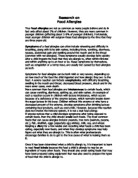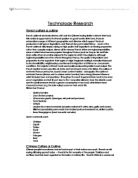Once it has been determined what a child is allergic to, it is important to learn to read food labels because the food a child is allergic to may be an ingredient of many other foods. They should also avoid eating foods that may have been prepared using equipment that was also used to prepare the types of food that the child is allergic to.
When trying to determine what a child is allergic to, parents often incorrectly assume that if they have eaten a food before and not had problems, then they are probably not allergic to that food. Parents usually only suspect new foods as being able to cause a food allergy. However, it is important to keep in mind that it takes time for the immune system to build up a reaction against something that the body is allergic to. It may take days, weeks, months or even years to build up enough of a response to cause noticeable symptoms. So, a child may be allergic to a food even if they have eaten it many times before without any clear problems.
In addition to avoiding what maybe thought that the child may be allergic to, children with more severe reactions should be evaluated by their Paediatrician or an allergist. can often be done, either skin testing or RAST (radioallergosorbent test, a blood test to check for antibodies against certain things that a child may be allergic to) to see if specific food allergies can be found. In addition, a child can be prescribed an epinephrine autoinjection device (such as the EpiPen or EpiPen JR) and should wear a medical alert bracelet to notify others of their allergy, especially in the case of a sever allerg.
Preventing food allergies may be possible, especially if a child is at high risk of having a food allergy, including already having an allergy to food or formula, eczema, hayfever, or asthma, or having other family members with these conditions or a food allergy.
Most importantly, breastfeed and avoid supplementing with infant formula or offering solids for at least the first six months. If a parent is not breastfeeding or need to supplement, then consider using a hypoallergenic infant formula (soy formulas and goat's milk may not be good alternatives, because many infants that are allergic to cow's milk may also be allergic to soy). If parents are breastfeeding, then they should avoid milk, eggs, fish, peanuts, and tree nuts in their own diet.
If a child is at high risk of having food allergies, parents should delay offering solids until they are at least six months old (and continue breastfeeding), and begin with an iron fortified infant cereal. It is best to start with rice and oat cereals and introduce wheat cereals later. Next, introduce vegetables, but avoid legumes (foods in the bean and pea family) at first, and then non-citrus fruits and fruit juices. Meat and protein foods can be added once a child is 8-9 months old.
Foods to avoid until an infant is at least a year old include cow's milk and other dairy products, citrus fruits and juices, and wheat. Also, avoid giving eggs until age two, and peanuts (as smooth peanut butter) and shellfish until a child is at least three years old. Whole peanuts and tree nuts should be avoided until a child is four because of the choke hazard.
When parents do introduce new foods, do so slowly and only give one new food every four to five days. This way, if a child does have a reaction or allergy, then parents will know which food caused it and they will be able to avoid giving it again.
Common
Food Allergies
Cow's milk is the most common cause of food allergies (in addition to being a common cause of food intolerances). Unlike cow's milk intolerance which is usually a reaction to the sugar lactose, allergies to cow's milk are usually from the proteins that are in the milk. Infants who have an allergy to cow's milk based formulas should usually be changed to an elemental or hydrolyzed formula, such as Nutramigen or Alimentum. Soy formulas and goat's milk may not be good alternatives in this case, although they usually are for older children, because many infants with allergies to cow's milk proteins are also allergic to the proteins in soy and goat's milk.
Other foods to avoid if a child is allergic to cow's milk include, but are not limited to, buttermilk, cheese, evaporated and condensed milk, ice cream, yogurt, instant mashed potatoes, margarine, casein, cream, hydrolysates, lactalbumin, nougat, sour cream, whey, and other foods made with milk or milk products. Older children who are unable to drink milk or eat milk based foods should be sure to have additional sources of in their diet, including calcium fortified juices.
Eggs, especially the proteins in egg whites are also a common cause of food allergies. To help prevent allergies to eggs, it is a good idea to avoid giving egg whites to infants under a year old. Other foods to avoid include, but are not limited to foods that are derived from eggs, including egg substitutes, and foods that contain albumin, globulin, ovalbumin and vitellin. Also avoid foods that are prepared with eggs, which may include French toast, cake, cookies, pancakes, eggnog, bread, ice cream, pasta, puddings, creamy salad dressings and foods with custard or cream fillings.
Soybean allergies are usually found in infants given a soy formula, but can also be found in older children who drink soy milk. Other foods that contain soy proteins and may cause allergic symptoms in children allergic to soy include, but are not limited to tofu, miso soup, soy sauce, foods prepared in soybean oil, veggie burgers and hot-dogs, and ingredients on a food labile including emulsifiers, hydrolyzed or textured vegetable protein.
Wheat allergy can develop in infants given a wheat cereal, and is probably best to offer a rice or oat cereal first and delay giving wheat until after a child is 6-8 months old. Other foods that may cause problems in children allergic to wheat include, but are not limited to many breads and cereals (unless they are made from oats, rye, corn or rice) made with wheat flour or enriched flour. Also avoid foods with cornstarch, gluten, semolina, all purpose or white flour.
Peanuts are not true nuts, but rather are actually legumes from the pea and bean family. Children with allergies to peanuts can be very sensitive to foods with even very small amounts of peanuts in them. Avoid all foods with peanuts, including candy, baked goods, chili, many ethnic foods (including Thai, Asian, and Indonesian foods), peanut butter, and mixed nuts. Children who are allergic to peanuts can often eat tree nuts, such as walnuts or pecans, since they are from separate plant families.
Tree nut allergies are also possible, and can include allergies to walnuts, pecans, cashews, almonds and hazel nuts and other nuts in hard shells. Parents should avoid foods prepared with tree nuts, including many kinds of candy, baked goods and different oils.
Corn is rarely a cause of food allergies. If a child does seem to be allergic to corn, they should avoid corn based cereals and breads, corn syrup, and caramel.
Certain food dyes and preservatives, especially sulfites, may also cause food allergy symptoms.
Reminders where Food
Allergies are Concerned
- While children often outgrow their food allergies, if a child had a severe reaction to a food, then parents should talk with their Pediatrician or allergist before reintroducing the food again to the child.
- Talk with and educate other family members and caregivers about their child's food allergies. Most people do not understand how serious food allergies can be, and may think it is all right to give just a small amount of a food that a child is allergic to.
- Educate the child about their allergy, so that they can learn to avoid foods that they are allergic to.
-
If a child does not improve with these interventions or if they have had a severe allergic reaction, then they should consider having them see an allergy specialist for testing to figure out what foods they are allergic to and to possibly start allergy injections.
-
Children with severe allergic reactions or anaphylaxis should wear a medical alert bracelet to notify others of their condition and should carry an epinephrine auto-injector (such as the Epi Pen JR) to ensure rapid treatment during an allergic reaction.
-
Most importantly, learn to read food labels and look for ingredients that a child may be allergic to and practice strict avoidance of those foods. If parents don't know what an ingredient is, then call the manufacturer before giving it to the child to be safe.







